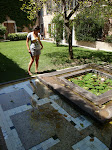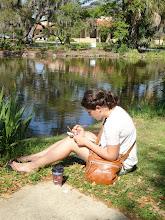It was quite amazing, incredible; the architecture, the tangible culture, the pleasant, beautiful climate, and the constant visibility and, if not visibility, then the presence of water.
Water was everywhere.
New Orleans could almost be an island. Lake Pontchartrain to the north, the Mississippi to the south, the canal cutting the city almost in half, and endless bayous and small streams and lakes everywhere you turn.
Bayou St. John was my first look at a bayou of any kind. Calming, cool, much breezier than the neighborhoods just across the street, eliminating the beating of the sun on my shoulders. Expecting to be consumed by humidity, I was pleasantly surprised to hardly experience any. From speaking with locals, we came at a prime time because the humidity has not set in yet. In addition, we stayed at a friend's house about 2 blocks from Bayou St. John, so we constantly felt the cooling breeze.
 The first exploration around Mid City, where I stayed and conveniently focused my explorations around, brought the discovery of the flooding that occurred in the area during Katrina. I had not expected it to have been hit so badly. The flood lines were about six and a half feet high! There's a beloved tavern on the bayou, Parkway. It's known for its mean roast beef and gravy poboy (submarines). The bartender talked to us about how they saved the restaurant, and showed us a photo of the place more than halfway submerged after Katrina.
The first exploration around Mid City, where I stayed and conveniently focused my explorations around, brought the discovery of the flooding that occurred in the area during Katrina. I had not expected it to have been hit so badly. The flood lines were about six and a half feet high! There's a beloved tavern on the bayou, Parkway. It's known for its mean roast beef and gravy poboy (submarines). The bartender talked to us about how they saved the restaurant, and showed us a photo of the place more than halfway submerged after Katrina.The bayou ends a couple blocks away from our entrance upon it. It just ends. I found that kind of odd. It appears to want to continue if it was allowed. Just after the ending, an asphalt paved street runs perpendicular on only about a 3' high levee-type mound. Beyond the street is a small median of grass that sinks in the center, soggy and heavy with water; that is my evidence of the desire of the water to continue.
Another street perpendicular, without houses so in visible distance from the end of the bayou, lies a strange subterranean canal-type thing. From the ground horizon, all that is seen is a line of concrete. It could almost be a foundation, but the concrete continues as far as the eye can see. When looking down inside, a good 10' drop inside, and it was full of water, but only about 2' deep at the bottom. This condition occurred the entire way. We followed it to see if we could decipher its purpose. It certainly ran alongside an uncomfortable neighborhood, or let's say grouping of shotguns. At the end, we discovered what appeared to be a pumping station. That's my best guess. It ended, on a small incline, instead of the normal flat plane that occurred the rest of the length. Then back up on the surface, there was a small structure, like a house, and across the street was the station. It certainly related to the water because there were enormous 5' diameter pipes connecting the building to the ground.







reminds me of Pleasant Valley Parkway in Providence!
ReplyDelete